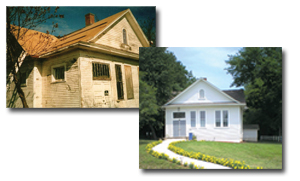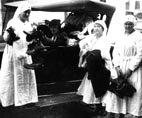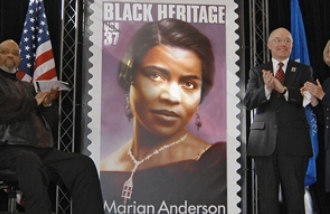
Volume 143, Number 4, July/August 2009, Page 4
By Lena Anthony
Photos courtesy of Marcia Hicklin
Think one person can’t make a difference in preserving America’s history? Clearly you haven’t met Marcia Hicklin. In 2003, this longtime corporate project manager set out to complete her most complicated project yet—saving an early 20th-century schoolhouse from ruin in her family’s hometown of Lexington, Mo.
The schoolhouse had special meaning to Ms. Hicklin. Her father and all of his siblings attended the Hicklin School, which was open from 1914 until 1957. The schoolhouse was also located at the edge of her family’s 200-acre property, and Ms. Hicklin recalls playing around it as a child on summer vacations to Missouri.
“It looked haunted,” says Ms. Hicklin, who had never gone into the schoolhouse until the early 1990s. “It was in really bad shape. It had holes in the floor, lots of mice and black snakes in it, and plaster was falling off the walls.”
In 1995, her father started work on stabilizing the schoolhouse, but got only as far as replacing the roof and painting the exterior when ill health forced him to stop working. After he died in 2000, Ms. Hicklin, who was then working in Atlanta, returned to Lexington to help her mother with the farm. Seeing the half-renovated schoolhouse gave Ms. Hicklin an idea.
“Knowing that Dad would have wanted the school to be preserved and that restoration would be costly, I researched available Missouri state and federal preservation tax credit programs,” she says. “In 2003, I began the process to put the school on the National Register of Historic Places. My plan was to apply for tax incentive credits after the project was complete, but the building first had to be on the register to qualify.”
After eight grueling months of application drafts and research, which included interviews with former students and teachers, the school was placed on the register in February 2004. With an ambitious plan to complete the work in 12 months, a small savings account and financial assistance from her mother, Ms. Hicklin lined up contractors—and neighbors—to gut and renovate the entire interior of the schoolhouse.
In true project manager style, Ms. Hicklin completed the renovation by the deadline. Today, the schoolhouse features living and dining areas in the main classroom, a full kitchen and bathroom, as well as the original pitcher pump and chalkboard. Visitors to Lexington can rent the School House Suite, as it is now called.
“I would love to live there,” Ms. Hicklin says. “It’s a monument to the simplicity of early 20th-century rural life. People have huge houses today with thousands of wasted square feet, but this place has only 900 square feet. It has everything one needs—I could live in it and be happy.”
Ms. Hicklin says the renovated schoolhouse also helps honor the memory of the hundreds of rural children who walked miles every day to the school. “I don’t think people appreciate how hard it was to get an education during the early 20th century.”

In 2005, Ms. Hicklin celebrated the school’s nearly complete renovation by participating in Lexington’s Preservation Day tour. When former students walked into the schoolhouse that day, they were greeted with a surprise—a first cut of the documentary film that Ms. Hicklin compiled from their interviews.
The idea for the film sprang from her research for the National Register. “Initially, I collected data for the application from the students via questionnaires, but their stories were so good, and they had so much fun telling them, that I asked a video professional friend to film them,” she says. “I thought it would be good for our local history to capture the stories of school days at Hicklin School from the few folks who attended it and were still alive.”
Filming started in August 2004 and wrapped the next year. In early 2006, Ms. Hicklin sat down with the videographer to finish the final edit. “I had never produced a documentary, so that, too, was a huge learning experience,” she says. “I’m glad I did it, not only for the community, but also because it may be the only video I have of my aunts, uncles and cousins and their lifelong friends.”
For her accomplishments with both the schoolhouse and the oral history project, Ms. Hicklin, who is a member of the Westport Chapter, Kansas City, Mo., was awarded the DAR Historic Preservation Medal, which was presented to her at the Missouri State Conference in 2006. “It was so exciting to get the award,” Ms. Hicklin says. “But it was probably most exciting to thank my mother, Alma Hicklin, my aunt Virginia Hicklin Thieman and Missouri State Curator Mary Holmes in front of all of those people.”
With her first restoration project completed, Ms. Hicklin is already thinking about the next one.
“There are buildings all over the country just like the Hicklin School that are being torn down because they’re in the way of developers,” she says. “I hope to send the message that anyone can do what I did, and that money and resources are available to help you restore these structures that are such an important part of our history.”








